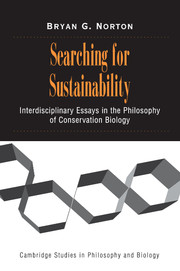Book contents
- Frontmatter
- Contents
- Searching for Sustainability
- General Introduction: An Interdisciplinary Experiment
- I PRAGMATISM AS AN ENVIRONMENTAL PHILOSOPHY
- II SCIENCE, POLICY, AND POLICY SCIENCE
- III ECONOMICS AND ENVIRONMENTAL SUSTAINABILITY
- IV SCALING SUSTAINABILITY: ECOLOGY AS IF HUMANS MATTERED
- 15 Context and Hierarchy in Aldo Leopold's Theory of Environmental Management
- 16 Scale and Biodiversity Policy: A Hierarchical Approach, with Robert E. Ulanowicz
- 17 Ecological Integrity and Social Values: At What Scale?
- 18 Change, Constancy, and Creativity: The New Ecology and Some Old Problems
- 19 Democracy and Sense of Place Values in Environmental Policy, with Bruce Hannon
- V SOME ELEMENTS OF A PHILOSOPHY OF SUSTAINABLE LIVING
- VI VALUING SUSTAINABILITY: TOWARD A MORE COMPREHENSIVE APPROACH TO ENVIRONMENTAL EVALUATION
- Index
16 - Scale and Biodiversity Policy: A Hierarchical Approach, with Robert E. Ulanowicz
Published online by Cambridge University Press: 21 January 2010
- Frontmatter
- Contents
- Searching for Sustainability
- General Introduction: An Interdisciplinary Experiment
- I PRAGMATISM AS AN ENVIRONMENTAL PHILOSOPHY
- II SCIENCE, POLICY, AND POLICY SCIENCE
- III ECONOMICS AND ENVIRONMENTAL SUSTAINABILITY
- IV SCALING SUSTAINABILITY: ECOLOGY AS IF HUMANS MATTERED
- 15 Context and Hierarchy in Aldo Leopold's Theory of Environmental Management
- 16 Scale and Biodiversity Policy: A Hierarchical Approach, with Robert E. Ulanowicz
- 17 Ecological Integrity and Social Values: At What Scale?
- 18 Change, Constancy, and Creativity: The New Ecology and Some Old Problems
- 19 Democracy and Sense of Place Values in Environmental Policy, with Bruce Hannon
- V SOME ELEMENTS OF A PHILOSOPHY OF SUSTAINABLE LIVING
- VI VALUING SUSTAINABILITY: TOWARD A MORE COMPREHENSIVE APPROACH TO ENVIRONMENTAL EVALUATION
- Index
Summary
INTRODUCTION
There exists a broad consensus supporting the protection of biological diversity; but the exact meaning of this consensus for policy is not clear. In the United States, for example, the Endangered Species Act emphasizes protection of species. But this emphasis has led to the question: Since approximately 99% of all species that have existed on earth are now extinct, how can it be so urgent that we reduce anthropogenic species extinctions? The standard answer to this question – that extinction itself is not bad, but rather that the accelerated rate and broadened scale of extinctions are unacceptable – likewise raises more questions than answers. One might ask, what would be an “acceptable” rate of extinctions? If species are not sacrosanct, what then is the proper target of protection? These questions are important because our inability to answer them indicates huge gaps in our understanding of environmental management and of biodiversity protection: It is not clear at what scale the problem of biodiversity loss should be addressed, Nor is it clear that measuring rates of species loss is the only or best criterion for measuring the success or failure of protection efforts.
In this paper we explore the policy implications of a hierarchical approach to protecting biological diversity. The hierarchical approach, which represents a specific application of general systems theory, models natural complexity as a hierarchy of embedded systems represented on different scales.
- Type
- Chapter
- Information
- Searching for SustainabilityInterdisciplinary Essays in the Philosophy of Conservation Biology, pp. 288 - 304Publisher: Cambridge University PressPrint publication year: 2002
- 1
- Cited by



